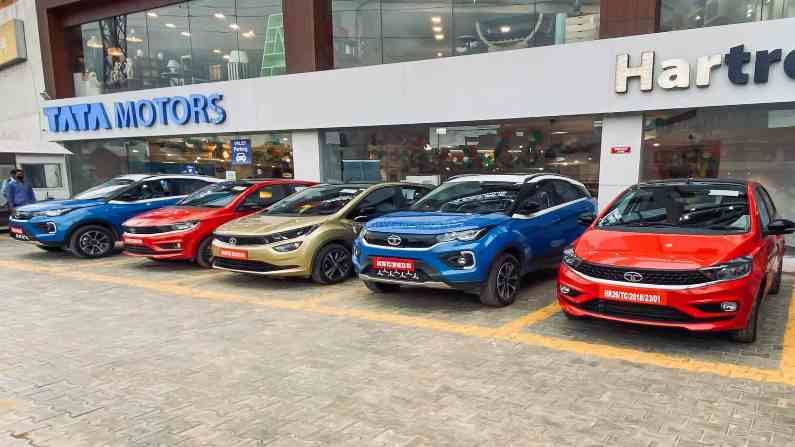Despite widening of loss brokerages are bullish on Tata Motors; here’s why
Tata Motors should witness a gradual recovery from Q2FY22 lows as supply-side issues ease and commodity headwinds stabilize

Shares of Tata Motors rose 1.41% to Rs 492.55 apiece a day after its consolidated loss widened to Rs 4,442 crore for the quarter ended September 30 (Q2FY22), against loss of Rs 314 crore reported in the same quarter last year. It had reported a loss of Rs 4,451 crore in the June quarter.
The consolidated revenue came in higher at Rs 61,379 crore, compared to Rs 53,530 crore in September 2020 quarter. Revenues in Q1FY22 stood at Rs 66,406 crore. The performance of the company took a hit owing to lower volumes at its Jaguar Land Rover (JLR) business due to the COVID-induced global chip shortage that hit production. Margins came under pressure due to high commodity prices.
Despite the company’s performance taking a hit owning to chip shortage and high raw materials prices brokerages are gung ho on the stock. Here is what they have to say.
Jefferies | Rating: Buy | Target: Rs 625
Tata Motors Q2 EBITDA (Earnings Before Interest Tax Depreciation & Amortisation) fell 23% QoQ led by chip shortage at JLR (Jaguar Land Rover). However JLR believes that worst of chip shortages is behind & volumes will gradually improve. The company is seeing good demand and has a strong order book. Next gen Range Rover sport launches should boost volumes at JLR. Simultaneously demand recovery, market share gains & better margins to help India business.
Motilal Oswal | Rating: Buy | Target: Rs 565
Tata Motors should witness a gradual recovery from Q2FY22 lows as supply-side issues ease and commodity headwinds stabilize (for the India business). It would gain from the triple benefits of: a macro recovery, company-specific volume/margin drivers, and sharp improvement in free cash flows and leverage in both JLR as well as the India business. The stock trades at 15.2x FY23E consolidated P/E (price to equity) and 4.1x EV/EBITDA (enterprise value to earnings before interest tax depreciation & amortisation).
Antique | Rating: Buy | Target: Rs 550
Tata Motors’ operating performance in Q2FY22 was adversely impacted by semi-conductor shortage and commodity inflation. JLR EBIT (Earnings before interest & tax) margin contracted QoQ, due to lower wholesale sales volumes because of semi-conductor chip shortages. Management expects chip availability to gradually improve starting from Q3FY22E, hence JLR will likely report positive EBIT margin and positive FCF (Free Cash Flow) in 2HFY22E. JLR continues to see strong demand for its models and has highest ever global retail orders of over 125,000, representing more than three months of sales cover. India business profitability improved despite steep commodity inflation, primarily due to higher sales volume of commercial vehicles (CVs) and Passenger Vehicles (PVs). India CV business is poised for a cyclical upturn over the next two years, while PV business turnaround is being led by success of its new models. The company generated negative FCF of Rs 3,800 crore in 2QFY22.
(Disclaimer: The recommendations in this story are by the respective research and brokerage firm. Money9 & its management do not bear any responsibility for their investment advice. Please consult your investment advisor before investing.)
Download Money9 App for the latest updates on Personal Finance.
Related
- देश का विदेशी मुद्रा भंडार 4.47 अरब डॉलर घटकर 688.1 अरब डॉलर पर
- मौद्रिक नीति पर निर्णय से पहले सेंसेक्स 308 अंक टूटा, निफ्टी भी नुकसान में
- जी एंटरटेनमेंट के शेयरधारकों ने प्रवर्तक संस्थाओं से 2,237.44 करोड़ जुटाने के प्रस्ताव को किया खारिज
- 15 जुलाई तक मक्का, धान की फसलों का बीमा कराएं किसान: हमीरपुर जिला अधिकारी
- सेंसेक्स की शीर्ष 10 कंपनियों में से नौ का बाजार पूंजीकरण 2.34 लाख करोड़ रुपये बढ़ा
- नेस्ले इंडिया के निदेशक मंडल के 1:1 बोनस शेयर जारी करने को दी मंजूरी दी

